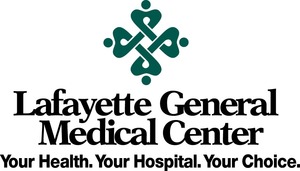At Lafayette General Medical Center, Advertising-Driven Patient Traffic Goes Up, Up, Up. But Media Spending? That’s Down.
Notable Health Care Advertising
// By Peter Hochstein //
 There’s nothing new about testimonial advertising campaigns for hospitals, right?
There’s nothing new about testimonial advertising campaigns for hospitals, right?
Well, not so fast. Sometimes factors ranging from how the testimonials are executed, to the community where they’re broadcast, to even the media strategy, can make a striking difference.
 A case in point, the testimonial campaign created for Lafayette General Medical Center in Lafayette, Louisiana, a 365-bed institution at the time of this writing. (It was scheduled to soon add 147 beds by expansion and an acquisition.) The campaign was created by Russo, a Lafayette advertising agency.
A case in point, the testimonial campaign created for Lafayette General Medical Center in Lafayette, Louisiana, a 365-bed institution at the time of this writing. (It was scheduled to soon add 147 beds by expansion and an acquisition.) The campaign was created by Russo, a Lafayette advertising agency.
One specialty, obstetrics, which got a large share of Lafayette General’s media budget, has seen its volume grow by double digits every year since the campaign was launched, according to figures gathered by the State of Louisiana and supplied via Russo. Meanwhile, one of Lafayette General’s key competitors lost share of births. And the Lafayette General gains keep on coming.During the past fiscal year, which ended in October 2015, “deliveries increased 23 percent,” says Daryl Cetnar, Director of Communications for Lafayette General Health, the medical center’s parent company. “Surgery was up 9.5 percent. Inpatient admissions 4.6 percent.” And furthermore, “It’s still climbing.”
What did Lafayette General do? No, it didn’t pump in more media dollars. Quite the opposite.
Russo offered a case history, which says media spending decreased by 18 percent. Nevertheless, reach and frequency simultaneously increased by 34 percent. And the cost per rating point dropped more than 61 percent. How did the agency manage that kind of media math?

Jaci Russo, Co-Founder and Senior Partner of Russo
As Jaci Russo, Co-Founder and Senior Partner of Russo, explains it, the savings came from completely redesigning the media strategy and switching a significant portion of dollars out of print and into television and radio. “I’m pretty sure the newspaper still hates us for it,” Russo says.
“We asked, where are people spending their [media consumption] time?” she continues. The answer, at least in Lafayette General’s marketing area, was broadcast. “We needed to bring a much heavier focus into the TV and radio mix because time spent listening in this market is very high, and there’s very heavy TV consumption,” Russo says.
Another advantage came from placing spots on a heavily viewed local cable channel that charges by advertising units, rather than by the length of spots. This enabled the agency to place many more 60-second spots than might be possible with the same dollars in other markets.
With a more efficient media strategy, says Russo, “We were able to deeply affect reach and frequency.” Although there are still some newspaper buys, “We also negotiated opportunities to use advertorials.”
But this wasn’t merely an exercise in media efficiency. It was also a case of the hospital discovering one of its key strengths—high patient satisfaction—and leveraging that with first-person stories reflecting the satisfaction.
The unscripted testimonials themselves are a bit different from many other hospital testimonial campaigns you’re likely to see. Not all of them show patients talking about illness and recovery. Some do, but others feature people who work at the medical center, talking about why they love what they do.
For example, one spot features an obstetrician. She announces, “I’m a delivery junkie. There is something very magical and very special about the time you clamp the cord and the baby takes its first breath. Then the baby gets a little—a little surprised look on its face. It’s great. It’s a very happy, special occasion for the family.”
The spots always show the person who’s speaking, especially when the speakers display emotion. But there are also cutaways that show high-tech aspects of the medical center’s facilities, and interactions between patients and doctors. In one spot, while a mother talks about how lucky she was to be at the only hospital in the area with an ICU and a natal ICU at the same facility, the camera sometimes cuts to scenes in the well-equipped natal ICU.
Both Russo and Cetnar insist the campaign gains extra strength because it’s running in a small city (population about 124,000). They also cite an intangible factor relating to the local Acadian culture, in which people are exceptionally accommodating to others. Regardless of the hard-to-define magic the culture creates, the small-city advantage is clear. People watching the spots are likelier to know the person on camera, or to know someone who knows them, than they would in bigger cities.
And then there’s the higher likelihood of serendipity. Cetnar says one hospital employee featured in a TV spot was stopped on the street by a passing stranger who took her picture—so the stranger could prove to her husband the people in the spots were “real people,” not actors.
How were the patients recruited? It was the caregivers who initially approached the patients and spoke to them about appearing in advertising. “Because the relationship between our caregivers and patients is so special, we asked those caregivers, mostly nurses and nurse managers, to identify people who were really extraordinary,” Cetnar says. “The best part of it is, we had a list about a mile long.” Then, when marketing staff called the patients, “we weren’t just some strange voice,” Cetnar says.
“They felt honored to be asked,” Cetnar says. “It goes back to the culture. We said, ‘We need your help to do this.’ And they were great.”
Useful Takeaway Points
- Tell a story. Emotional stories that make a point can be more powerful than a laundry list of facts. While Russo did cut down on standard newspaper ads, “we also negotiated opportunities for advertorials,” Russo says. “We made sure there were lots of stories—it wasn’t just ads anymore—it was stories that people wanted to read.”
- Don’t over-direct. “You have to remember that you’re letting the patient tell their story,” says Cetnar. “Don’t push your message. Don’t feed them lines. Let their passion and emotion tell everybody how great you were. That’s why we don’t have scripts. It’s just the patients’ raw emotions that come through.”
Peter Hochstein is a direct-response advertising consultant, business journalist, and author. He is the author of “Lessons from 9 Innovative Health Care Marketing Campaigns,” a white paper available at the SHCM website. You can reach him through his website, http://peterhochstein.com.
